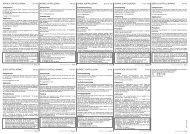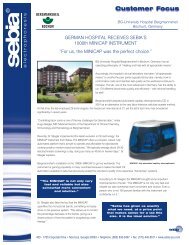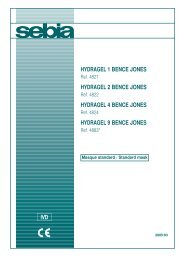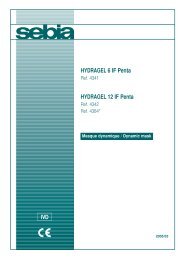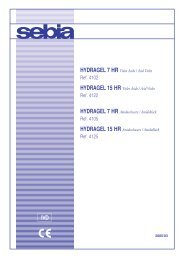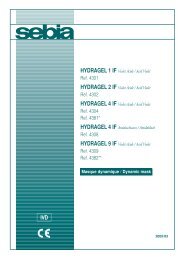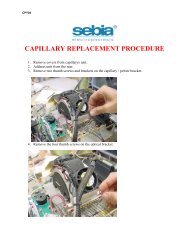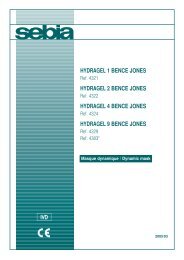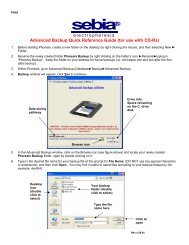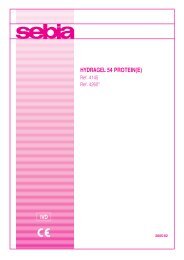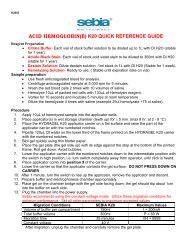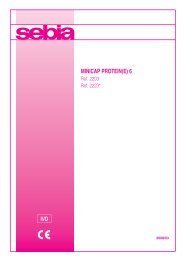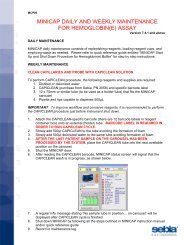CAPILLARYS HEMOGLOBIN(E)
CAPILLARYS HEMOGLOBIN(E) - Sebia Electrophoresis
CAPILLARYS HEMOGLOBIN(E) - Sebia Electrophoresis
- No tags were found...
Create successful ePaper yourself
Turn your PDF publications into a flip-book with our unique Google optimized e-Paper software.
<strong>CAPILLARYS</strong> <strong>HEMOGLOBIN</strong>(E) - 2010/10<br />
Hemoglobin O-Arab<br />
One glutamic acid of the ß-chain (No. 121) is replaced by lysine. With <strong>CAPILLARYS</strong> <strong>HEMOGLOBIN</strong>(E) procedure, hemoglobin O-Arab migrates<br />
exactly like hemoglobin A2. In such a case, hemoglobin A2 can not be quantified. When this fraction is > 9 %, hemoglobin O-Arab must be suspected.<br />
Note that Hb O-Arab migrates separately from hemoglobins C and E.<br />
Hemoglobin D (-Los Angeles)<br />
One glutamic acid of the ß-chain (No. 121) is replaced by glutamine. With <strong>CAPILLARYS</strong> <strong>HEMOGLOBIN</strong>(E) procedure, hemoglobin D (called D-Punjab,<br />
D-Los Angeles, D-Chicago or D-Portugal) migrates behind hemoglobin S, this property allows to differenciate S and D hemoglobins.<br />
2. Quantitative abnormalities: Thalassemias<br />
Thalassemias constitute a quite heterogeneous group of genetic disorders characterized by decreased synthesis of one type of the polypeptide chains.<br />
The molecular mechanism of this decrease has not been fully described.<br />
There are two types of thalassemia syndromes:<br />
Alpha-thalassemias<br />
They are characterized by the decrease of synthesis of the α-chains, consequently affecting the synthesis of all normal hemoglobins. The excess of<br />
synthesis of the ß- and γ-chains in relation to α-chains induces the formation of tetrameres without any α-chain:<br />
• hemoglobin Bart = γ4,<br />
• hemoglobin H = ß4.<br />
Hemoglobin H presents a low isoelectric point ; with <strong>CAPILLARYS</strong> <strong>HEMOGLOBIN</strong>(E) procedure, it migrates more anodic than hemoglobin A (and may<br />
appear as one or several fractions).<br />
Beta-thalassemias<br />
They are characterized by the decrease of synthesis of the ß-chains. Only hemoglobin A synthesis is affected.<br />
Therefore hemoglobin F and hemoglobin A2 percentages are increased with respect to hemoglobin A.<br />
With <strong>CAPILLARYS</strong> <strong>HEMOGLOBIN</strong>(E) procedure, values obtained for different normal hemoglobin fractions allow the detection of beta thalassemias.<br />
3. Particular cases<br />
• When there is no hemoglobin A in the sample, a small fraction may be observed in its migration zone ; this fraction may be acetylated hemoglobin<br />
F which represents about 15 to 25 % of hemoglobin F. The <strong>CAPILLARYS</strong> 2 FLEX PIERCING system can identify this acetylated hemoglobin<br />
separately from the hemoglobin A without any confusion.<br />
• When a small fraction (about 0.5 to 3 %) migrates between hemoglobins F and δA’2 (A2 variant), a hemoglobin A2 variant may be suspected.<br />
• When a hemoglobin A2 variant is detected (δA’2 or any other A2 variant), it is recommended to add its percentage to hemoglobin A2 for a better<br />
beta-thalassemia diagnostic.<br />
• Some hemoglobin variants (such as Hb Camperdown and Hb Okayama) migrate close to Hb A and may not be separated from this hemoglobin.<br />
• Some hemoglobin variants (such as Hb Porto-Alegre and degraded Hb S) migrate close to Hb F and may not be separated from it.<br />
• Weak hemoglobin fractions which migrate in zone Z12 are sometimes quantified with imprecision (too asymmetric Hb Bart’s, for example). It is thus<br />
necessary to delete automatic quantification and then to quantify them manually.<br />
• Weak fractions may be observed in Z14 and Z15 migration zones. It is then necessary to analyze the hematologic state of the patient and to perform<br />
complementary analyses in order to characterize these fractions (artefact or hemoglobin abnormality).<br />
• When analysing blood samples from newborn babies, Hb A from samples containing Hb F at high concentrations may be disturbed, especially due<br />
to the presence of degraded Hb F in its migration zone. The Hb A percentage indicated by the software may be overvalued. In addition, when<br />
hemoglobin variants (> 4 %, such as Hb S, Hb C, Hb E or Hb D-Punjab) are present in blood samples containing high Hb F levels (> 60 %), it is<br />
necessary to perform complementary analyses in order to confirm the presence of Hb A.<br />
• For newborn babies until 6 – 9 months old, it is recommended to analyze many blood samples (collected monthly, for example) in order to check<br />
the Hb F concentration. It will allow to verify the decrease of Hb F concentration and the potential presence of a variant. In case of uncertainty, it is<br />
advised to confirm by using complementary studies and to analyze parents’ blood samples.<br />
• Examples with increased hemoglobin F (Hb F) (except for newborn babies):<br />
- pregnancy ;<br />
- patients with sickle cell disease, more than 2 years old, with a Hydrea® (hydroxyurea) treatment and/or transfused and/or producing naturally Hb F<br />
increased by compensation ;<br />
- patients, aged more than 2 years old, with HPFH trouble (hereditary persistence of foetal hemoglobin exhibiting 20 to 40 % Hb F for heterozygous<br />
patients) ;<br />
- patients, more than 2 years old, with leukaemia (with any type), hereditary haemolytic anemia, diabetes, thyroid disease, hyperactivity of bone<br />
marrow, multiple myeloma, cancer with metastases.<br />
For further informations, please refer to: http://www.answers.com/topic/fetal-hemoglobin-test<br />
• When analysing blood samples from transfused patients with sickle cell disease, with low Hb A level (< 10 %), Hb S fraction may appear shifted<br />
from Z5 zone to Z6 zone. It is necessary to analyze the hematologic state and to perform complementary studies in order to confirm the presence<br />
of Hb S.<br />
Interference and Limitations<br />
• See SAMPLES FOR ANALYSIS.<br />
• Analyze only blood samples contained in collection tubes indicated in the paragraph "EQUIPMENT AND ACCESSORIES REQUIRED" or tubes with<br />
equivalent dimensions approved for clinical assays. Call SEBIA technical service for further information on these devices.<br />
• Do not analyze directly tubes containing less than 1 mL of blood sample.<br />
• Avoid aged, improperly stored blood samples ; degradation products (or artefacts) may affect the electrophoretic pattern after 7 days storage.<br />
• After 10 days storage, viscous aggregates composed in red blood cells may appear, they must be discarded before analysis.<br />
• When analysing blood samples with a decreased [red blood cells] / [plasma] ratio (from patients with anaemia), a hemoglobin Constant Spring<br />
variant may be suspected when a fraction is observed in Z2 or Z3 migration zones. This fraction may be due to plasmatic proteins present in the<br />
sample (see § Sample preparation, Particular cases).<br />
- 51 -



